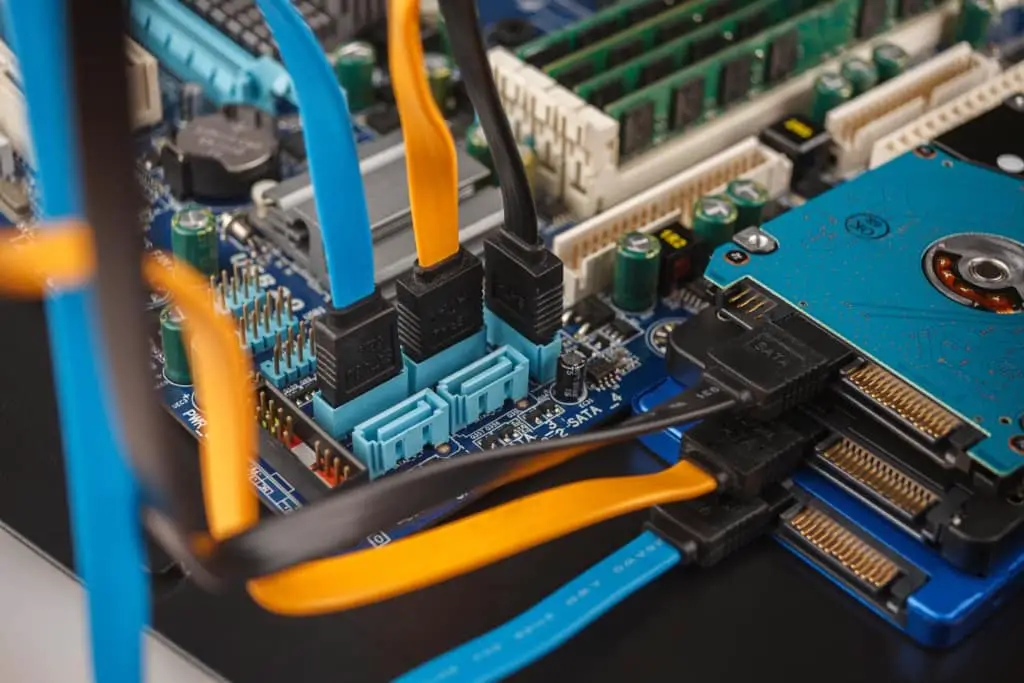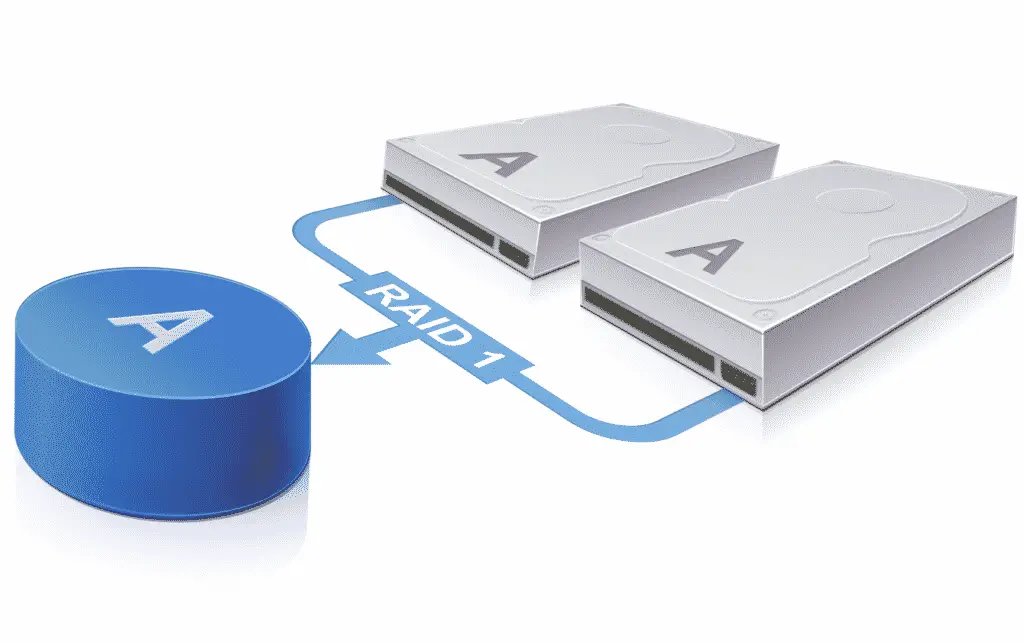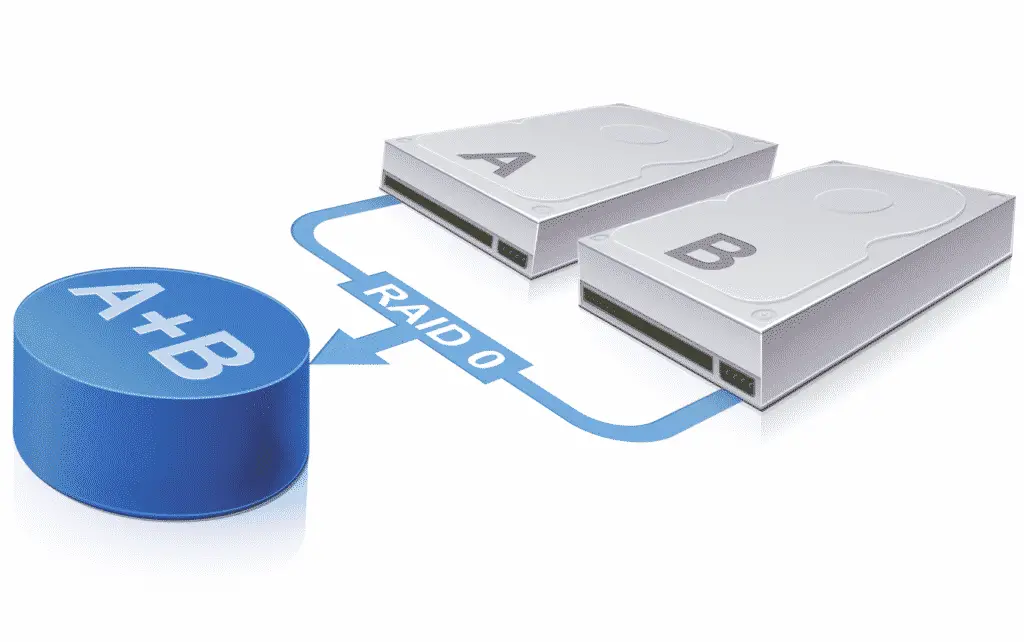
Image by daniiD on Adobe Stock
Every computer and notebook is equipped with a data storage device, but only very few users actively take care of the management and architecture of their hard drives. There are some simple ways to individually determine the storage and backup of your own data, which can have great advantages in everyday life.
There are two main methods for Windows computers that can be used to implement self-managed data storage for a certain benefit: the classic RAID array or the storage space provided by Windows 10.
The two systems are quite similar and have a comparable range of functions. But which one should you use? Is one – at least in certain areas of application – significantly better than the other?
RAID and storage spaces: the basic function
Both systems are basically the same principle. Two or more physical storage media – i.e. HDD hard disks or modern SSDs – are combined in a storage group in order to gain various advantages in everyday use.
There are several different options, depending on your own requirements and the exact goal that you want to achieve by sharing several hard drives:
- Expansion of storage space.
- Increase in write and read speeds.
- Increased data security.
- A combination of all the advantages mentioned.
To achieve this, it actually only needs at least two separate hard drives and a corresponding configuration, so that they work together as desired. There are two versions of the Windows PC that this article deals with: Firstly, the RAID system (“redundant array of independent disks”, ie a redundant grouping of independent hard disks) that has been in use for this purpose for a long time is – and now, since Windows 10, Microsoft’s own storage solution, which is often also called “Storage Spaces”.
There are various RAID levels in RAID, i.e. several model levels that describe how exactly the architecture is structured and what function it serves. For example, both hard drives can be interconnected to divide data into smaller parts and then save them separately. This way they can be saved faster, but also called up faster (RAID 0). Alternatively, the files are not separated, but doubled – this saves them twice separately, which means that there is always a backup copy if one of the hard drives is defective (RAID 1).

Image by Onidji on Adobe Stock |

Image by Onidji on Adobe Stock |
In order to achieve both the speed and the redundancy of the data at the same time, there are options such as RAID 5 or RAID 6. There are also other RAID levels that perform more complex tasks or are based on outdated methods – these are therefore significantly less common Commitment.
Microsoft therefore limits the function of its storage spaces to the three most frequently used options:
- Simple: No redundancy, only higher speed (function comparable to RAID 0).
- Two- or three-way mirroring: Multiple copies on multiple drives increase security. Three-way mirroring maximizes the available space, but requires at least five hard drives (function comparable to RAID 1).
- Parity: Multiple copies on at least three drives, so that a failure is secured, plus higher speed (function comparable to RAID 5).
If you want to set up a hard drive network, you can simply use the function brought by Windows. But does that mean that the RAID system has now become obsolete, or are there still important differences or features that would make the choice more likely?
The main differences
First of all, when comparing, please note that RAID is not the same as RAID. There are two fundamentally different options for creating such a storage pool: hardware and hardware RAID.
In the first variant, the following applies: For a RAID network, physical RAID controllers are required, which are actually components in the computer. So there is a limit to the number of hard drives that can be used in hardware RAID.
In contrast, in software RAID, the interconnection of the hard drives is completely controlled by programs or the operating system. This means that no RAID controllers are required, but a normal mainboard can be used without additional hardware. Attention: Many modern mainboards, especially models with higher performance, support the basic RAID levels ex works thanks to onboard controllers.
In the case of storage spaces, the hard disks can still be individually addressed and recognized by the system, which is not the case with RAID. This means, for example, that if two hard disks of different sizes are used, the excess RAID space is lost. Windows storage pools, however, can continue to use this storage space.
So that the mirroring or separation of the data works on several hard disks, of course some computing effort is necessary. With hardware RAID this is done by a small processor of the RAID controller, while in other variants the CPU of the computer has to do the work in addition to its normal tasks.
How are the different pools configured?
Depending on which variant is selected, the storage network must be set accordingly. The result is almost the same, but the procedure is very different:
- Hardware RAID: The hard drives that are to work together must be connected via the physical RAID controllers. The network must then be set up and configured in the system’s BIOS. This requires at least basic knowledge of working in the BIOS – where exactly this setting can be found depends on the manufacturer of the respective mainboard. The SATA configuration is usually located under the “Advanced” tab. After a reboot, either the RAID setting of the mainboard or, when using external RAID controllers, a separate BIOS starts. This can be called up during the boot process with the key combination Ctrl + i.
- Software RAID: Here, too, you move a little deeper into the operating system, but this shouldn’t be a problem for experienced Windows users. In disk management, empty hard disks can be combined to form a RAID system. This menu item is located in the Control Panel under the keyword “Create and partition hard disk partitions”. However, many motherboards also offer the option of activating a software RAID in the BIOS so that it can also be used for the operating system.
- Storage spaces under Windows: Here too the path leads via the control panel via the item “Manage storage space”. With a click on “Create new pool and storage space”, users with administrator rights can then select the storage media and connect them accordingly.
Advantages of RAID
- Hardware RAID offers the option of including the operating system. To do this, the “Bootable” option must be activated when setting the storage pool.
- Hardware RAID is more suitable for larger projects because the system processor does not have to work with it. With two or three hard disks, this hardly matters today, but the performance can drop noticeably with larger storage groups. If maximum performance is desired, RAID should continue to be used.
- More unusual RAID variants can only be implemented using hardware RAID. RAID 10, for example, where the mirroring and the division of the data into several storage locations are combined, typically only works with hardware.
- The best option for setting up a NAS home server.
- As software RAID independent of physical RAID controllers.
Advantages of storage spaces
- The easiest way to configure a storage pool. Even significantly lighter than a software RAID.
- Regardless of the connection of the hard drives. This means that even hard disks without an existing RAID controller can be connected. Even storage media that are connected via USB, for example, are available.
- No wasted memory when merging different sized partitions or hard drives. This recommends Windows storage pools especially for spontaneous use.
- Storage Spaces is completely sufficient for simple systems that are most likely to be used by private users. The drop in performance is practically not noticeable.
Conclusion: RAID or storage spaces?
So there are still application scenarios for all variants. Which option is ultimately used depends on the specific requirements, the level of knowledge, the available hardware and the requirements for the hard disk network.
For a redundant data backup in the private computer, a software RAID of two additional memories is sufficient – thanks to the simple configuration, however, Windows storage spaces should now be even more attractive.
If larger storage groups are created, so it is an ambitious project anyway, a hardware RAID is still the most efficient option.